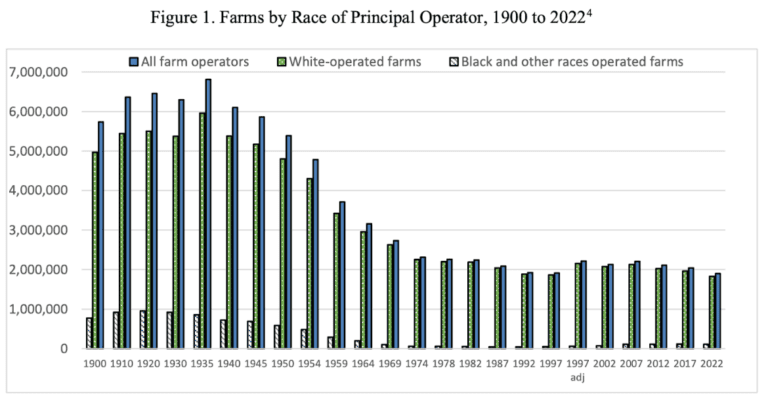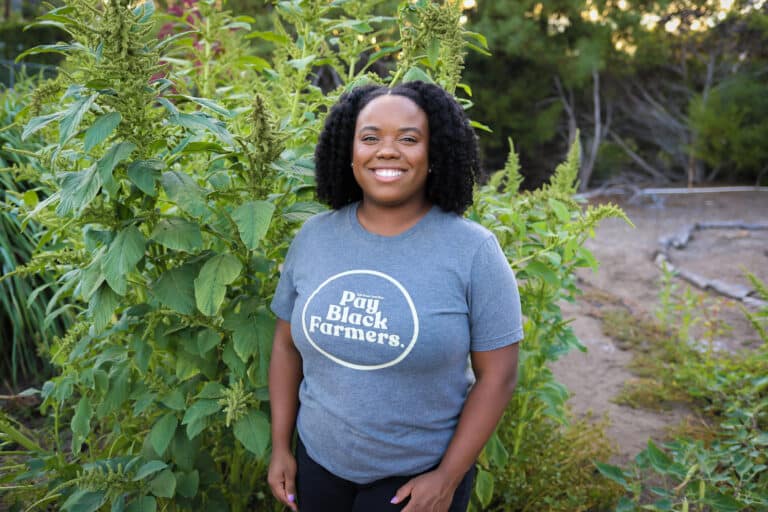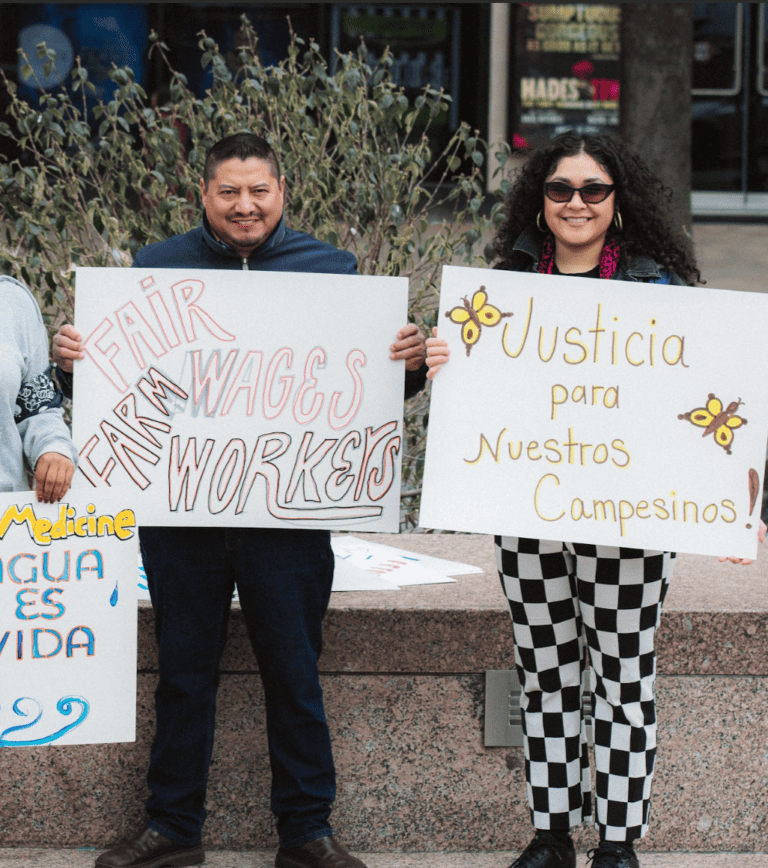By Nichelle Harriott, Policy Director
There is no question that for decades the U.S. Department of Agriculture (USDA) failed to serve millions of farmers who needed assistance accessing federal programs, loans and other resources to help keep their farm operations afloat. The USDA denied service to many of these farmers, mostly Black, Indigenous and People of Color (BIPOC), who lost their farms as a result. There have been many class action lawsuits including Pigford v. Glickman that present documented evidence of USDA’s pattern of racial discrimination. The USDA has admitted to this long history of racism, settled these cases, and began its long road to right its wrongs.
In January 2021, President Biden signed an Executive Order (E.O 13985) to advance racial equity throughout the federal government which led to the establishment of USDA’s Equity Commission in March 2021. The Commission’s task: to ensure that equity was made integral in USDA’s service and programming. After public input, review of USDA’s programs, historical reports and audits, and engagement with USDA leadership, the Equity Commission published its final report on February 22, 2024. The report puts forward 66 recommendations, all unanimously approved by the Commission, that focus on core areas of USDA’s work.
Recommendations for Systemic Changes
The Equity Commission made 66 recommendations touching the breadth of service and programming by USDA. The Equity Commission made recommendations with the goal of supporting low income communities, farmworkers, and feeding communities in need. According to Secretary Vilsack, the USDA is being tasked with understanding that each farmer, producer, and constituent in need has a point of view and life story and requires those at the agency to understand. This means that USDA leadership, career staff, and field officers must be equipped, culturally competent, and responsive to Black farmers’ mistrust of USDA but are in desperate need of financial assistance. It means that USDA must remedy Hmong farmers who may have had their applications delayed due to language barriers and that USDA acknowledges that tribal communities connected to forests already have traditional methods to treat and manage a healthy forest. USDA has a duty to serve all these communities and must hold itself accountable for meeting each need equitably.
To achieve this, the recommendations include:
- institutionalizing equity, accountability, and improving staff diversity at the USDA;
- equitable funding for community-led land access and transition projects, technical assistance and translation services to help applicants submit applications for programs;
- support for farmworkers and their families; and
- improved access to nutrition for disadvantaged and low-income communities.
Additionally, the report asks USDA to make changes to specific programs like conservation and procurement services by increasing set-asides for what they term minority farmers and minority-owned businesses to participate in and partner with the agency.
Equitable Climate Justice
BIPOC communities are often on the front lines when it comes to the devastating impact climate chaos has on agriculture. Yet, these communities are often the last to receive support from the USDA or other federal agencies. Many employers force farmworkers to work in extreme heat, while flooding in the Southeast has left many Black farmers underwater both physically and financially. The Commission’s report puts forward climate justice solutions to support women and BIPOC farmers and protect farmworkers from hazardous climate-related working conditions. It calls for USDA to support equitable climate justice action by increasing incentive payments for climate-resilient practices to ensure limited-resource farmers can participate in cost-share programs to support their operations.
The report also calls for USDA to support smaller, non-traditional farmers in accessing Environmental Quality Incentives Program (EQIP) funding and other environmental programs. USDA must also ensure Indigenous practices are integrated into the Natural Resources Conservation Services’ (NRCS) sustainable agriculture programs so that these farmers are fairly compensated. Specifically, to remedy historic exclusion of tribal communities, their traditional practices, and agricultural education from the federal network of extension services, the report also asks USDA to include Tribal Ecological Knowledge (TEK) as part of climate-smart agriculture definitions and practices.
Moving Forward
In response to the activities of the Equity Commission over the last couple of years, the USDA has begun to enact some of the top recommendations. In its recent progress report, USDA identifies action taken to ensure financial and technical assistance are more broadly accessible while creating new and better market opportunities for producers. In 2022, USDA announced its new grant and cooperative agreement program, Increasing Land, Capital and Market Access Program, making available $300 million to assist producers in accessing land, capital, and markets, to support producers who have been historically left behind in securing resources, technical assistance and other federal programs. The program funded 50 projects nationally, and demand for the program exceeded the program’s capability. In 2022, NRCS invested $50 million and in 2023 invested $70 million in partnerships to improve equity and access to conservation programs through Equity Conservation Cooperative Agreements.
To provide relief to distressed borrowers, the 2022 Inflation Reduction Act provided authority for the agency to provide relief for distressed borrowers who have at-risk farming operations with outstanding FSA loans. The FSA has provided approximately $2.2 billion in assistance to more than 39,500 distressed direct and guaranteed loan borrowers. Similarly, the legislation also directed USDA to provide financial relief to those who experienced discrimination while trying to access USDA’s lending program. Third-party organizations have been spearheading the administration of relief funds. Tens of thousands of applications were accepted during the application period which ended in January 2024, and are currently being reviewed.
To support farmworkers, USDA established the Farm and Food Worker Relief (FFWR) Program to provide $600 relief payments for farm and food workers who responded to and worked during the COVID-19 pandemic.
Shortcomings of the Report
We at the HEAL Food Alliance wholeheartedly support the Equity Commission’s tireless work and recommendations, many of which are reflected in our Platform for Real Food and Farm Bill Policy Recommendations, and include protecting farmworkers from heat stress, expanding financial and technical assistance to BIPOC farmers to access land and resources to begin or expand their operations, and ensuring that food insecure communities have access to nutritious food without arbitrary barriers limiting access.
While we encourage USDA to work quickly to prioritize the implementation of these recommendations and improve equitable access and resource allocation to its programs and services, there is still much work to be done to account for the 21.5 million people working in the food and agriculture system who are not adequately protected or equitably served by the USDA and other federal agencies. These workers, responsible for processing, packaging and putting food on our tables, continue to be overlooked and were not accounted for in the report. While the Equity Commission has put USDA on the path to right past wrongdoing, more is needed to protect all of us serving across the food chain.
Further, as highlighted by the Native Farm Bill Coalition, the Equity Commission’s report falls short in acknowledging that tribal governments are sovereign governments that have jurisdiction and decision-making authority over tribal lands. In failing this, it continues to overlook the rights and unique challenges tribal nations have in defining how and when they engage with the USDA – another federal entity. More consultation and engagement with sovereign tribal governments is necessary in order to fully comprehend each tribal nation’s unique needs and cultural worldview, so that their needs can be equitably supported.
Next Steps
The USDA has taken many positive steps to improve how it serves farmer customers. But the work is far from over. According to the 2022 Census of Agriculture, BIPOC farmers continue to receive disproportionately less in federal loans and other resources compared to their white counterparts. Black farmers in particular have lost more farms than any other demographic. To reverse these troubling trends, the Equity Commission’s recommendations put USDA on a path to address these wrongs and institutionalize a new culture at the agency. USDA, from leadership to field officers, must recognize the importance of treating everyone they serve with dignity and respect; and have the cultural competence required to provide high quality, consistent, and equitable service to every person walking through USDA’s doors..
The HEAL Food Alliance is committed to supporting USDA implement the Equity Commission’s recommendations; and where possible, will work with Congress to ensure USDA has long-lasting authority to strengthen the agency’s service and programs so that all producers are supported.
Here is a quick snapshot the Commission puts forward for USDA to enact:
Procurement: Create set-asides for minority, Tribal, and women-owned small agricultural businesses; Provide technical and financial assistance to support small and BIPOC owned agricultural and food businesses; Incentivize major contractors to form partnerships with these small agricultural businesses.
Heirs property: Provide multi-year grants and/or cooperative agreements to 501c3 organizations to deliver technical assistance and education that will prevent the creation of heirs’ property and remedy title issues that cause heirs’ property.
Institutionalizing equity, accountability, and improving staff diversity: Review equity plans and support workforce diversity and cultural competency by enhancing and improving job descriptions and hiring requirements to prioritize demonstrated experience with target populations.
Land access: Ensure equitable funding to community-led land access and transition projects to create land security for farmers; Increase investments in the Heirs’ Property Relending Program; Engage with Indigenous and community-based organizations to ensure that heirship issues also address “fractionization” issues that Tribal communities face.
Language access: Increase funding for technical assistance to be linguistically and culturally appropriate; Invest in local community-serving organizations through cooperative agreements with tribes, acequias, and organizations.
Conservation: Ensure Indigenous practices are integrated into NRCS’ sustainable agriculture programs and support smaller, non-traditional farmers in accessing conservation programs; Increase incentive payments for climate-resilient practices to ensure limited-resource farmers can participate in cost-share programs; Better integrate, and equitably compensate for the use of Indigenous knowledge and land management practices; Support climate justice solutions that target resources to women and BIPOC farmers and protect farmworkers from hazardous working conditions due to climate change.
Technical assistance and outreach: Allocate funding for third-party organizations to provide technical assistance to help applicants submit competitive applications for programs; Develop and implement innovative, culturally responsive communication platforms and outreach strategies to expand targeted outreach
Supporting Farmworkers and their families: Establish an Interagency Farmworker Service Council which will help USDA drive accountability, coordination, compliance, and culture change at a systems level to protect farmworkers from continued inequities; Improve language access, technical assistance and distribution programs to ensure farmworkers and their families are able to access nutrition programs available to them; Direct the USDA Office of the Inspector General (OIG) to conduct a report or a joint report from USDA and Dept of Labor (DOL) on farmworker living and working conditions that are essential to understanding the needs of farmworker populations; Ensure that funds for employer grants and procurement promotes improved farmworker living and working conditions by requiring that employers throughout the supply chain demonstrate labor law compliance; Ensure funding for farmworker organizations help improve farmworker working and living conditions and access to economic opportunities; Ensure that farmworkers and their families are equally included in programs that address the impact of pandemics, natural disasters, and climate change, etc.
Improving Nutrition Access: Support legislative action to remove eligibility restrictions on the Supplemental Nutrition Assistance Program (SNAP) that disproportionately limit access to nutrition supports by BIPOC; Review and update the Thrifty Food Plan (TFP) to reflect the needs of today’s consumers; Seek legislative authority to hold states accountable for barriers to access; Identify barriers to vendor and procurement opportunities for disadvantaged and underrepresented communities
Recognizing Immigrants and their families: Support policies that lead to pathways to access citizenship and family reunification


